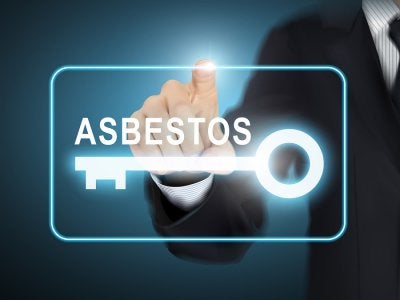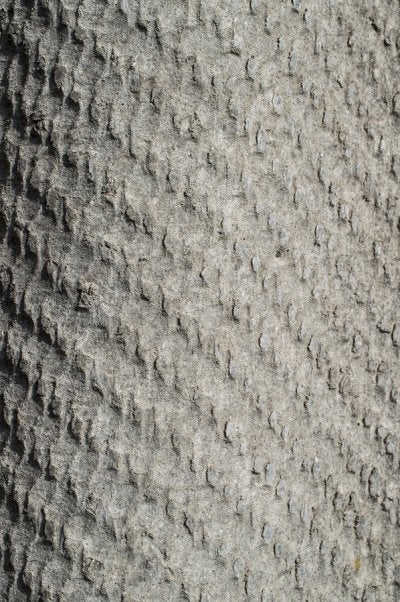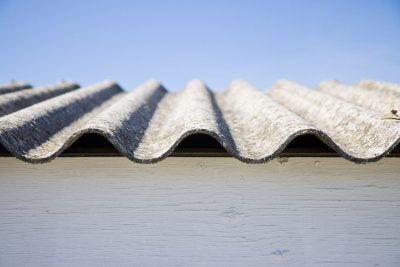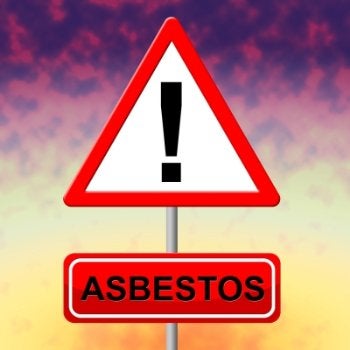-
What You Need to Know about the Dangers of Asbestos
Asbestos is a material that was used in construction projects for decades before it became evident that it could cause dangerous health problems. While houses built in recent years should not contain any asbestos, it was regularly used in residential construction up until the 1980s. This is why it is important for homeowners to know about the dangers of asbestos and what to do to avoid them. If you are concerned that your home may contain asbestos, contact a company that offers asbestos testing in San Francisco, and read the following information to find out more about the dangers of asbestos.
Asbestos can cause life-threatening health problems.

It is very difficult for the body to break down asbestos fibers, which means that when they are inhaled or ingested, they can remain in the body for years. With time, this can lead to a number of chronic diseases that may be life-threatening. Asbestosis is a type of respiratory disease that can cause shortness of breath and may lead to heart failure. Another disease that can result from asbestos exposure is lung cancer, which may be deadly. Asbestos exposure can also lead to mesothelioma, a type of cancer that can affect the membrane which lines the lungs, abdomen, and heart. Cancers of other areas of the body, including the stomach and esophagus, can also result from asbestos exposure.
Asbestos is dangerous when disturbed.
While asbestos may be present in different materials in your home, it generally will not be dangerous if it is not disturbed. However, any activity that can release asbestos fibers into the air, such as demolition or remodeling, can put your family at risk. This is why it is essential to schedule asbestos testing before you begin a project in your home. If asbestos is detected, professional removal or containment will be necessary before you can proceed with your home improvement project.
-
Why Should You Be Concerned About Asbestos?
There are enough things to worry about in life, especially if you have a family. But as if the list wasn’t long enough, there’s something else you should be concerned about if you aren’t already: Asbestos. It’s true that asbestos was outlawed for residential use in the United States in the 1970s, but there’s no guarantee that homes built before this time have been tested and made asbestos-free. Fortunately, there are air testing companies in San Francisco that can inspect your home for asbestos and make sure your family is safe. What exactly is there to worry about, anyways? Here are just a few of the diseases that can be caused by exposure to asbestos.
Mesothelioma

This cancer, which affects the lining of the lungs and the lining in the lower digestive tract, is almost exclusively related to exposure to asbestos. Tragically, by the time mesothelioma is diagnosed, it is almost always fatal.
Lung Cancer
Lung cancer related to asbestos looks the same as lung cancer causes by smoking and other causes. By some estimates, there is approximately one asbestos-related lung cancer for every mesothelioma death. In other words, lung cancer is a very serious and very real threat stemming from exposure to asbestos.
Asbestosis
Another serious lung condition causes by asbestos exposure is asbestosis. This condition causes scarring of the lung that leads to progressively worse breathing difficulties over time, and in some cases can even be fatal. Asbestosis normally occurs after heavy exposure over a long period of time.
Pleura Thickening
In addition to asbestosis, prolonged exposure to high levels of asbestos can also cause the lining of the lung (pleura) to thicken and swell. Over time, the lung itself can contract and make it difficult to breath. Shortness of breath and chest discomfort are common with sufferers dealing with pleura thickening due to asbestos.
-
A Look at FAQs About Asbesto
People who are familiar with diseases like mesothelioma are commonly worried about asbestos exposure in San Francisco. The EPA and CPSC have banned the use of most asbestos products in construction, but cutting or disturbing materials that contain these harmful fibers can lead to severe health issues. If you suspect your home may have asbestos, schedule a professional asbestos test before beginning any home improvement projects.
What is Asbestos?

Asbestos is a mineral fiber that was used in a variety of construction materials beginning in the early 1900s and up until the late 1970s. Asbestos was also used by most branches of the U.S. Armed Forces as insulation for vehicles, ships, and aircraft. The name asbestos describes a group of naturally occurring mineral silicates that crystallize into bundles of thin filaments. Asbestos cannot be identified visually and must instead be sampled, tested, and analyzed by a qualified professional.
How Can I Be Exposed to Asbestos?
Areas in proximity to asbestos mines can have higher concentrations of asbestos particles in the air due to weather and erosion inside the excavation tunnels. However, most people suffer asbestos exposure when nearby asbestos-containing construction materials are disturbed in some way. Drywall, insulation, floor and ceiling tiles, paint, and cement are just a few of the products that were once made using asbestos fibers. Asbestos exposure typically occurs after inhaling contaminated air.
What are the Health Effects of Asbestos Exposure?
When asbestos fibers are inhaled, most of them are removed through exhalation and coughing. If the body’s defenses fail to eliminate all of the fibers from the lungs, inflammation and scarring caused by the trapped particles can lead to decreased lung function. Long-term exposure to asbestos can cause lung cancer, mesothelioma cancer, asbestos cancer, asbestosis, lung disease, or chronic obstructive pulmonary disease. In most cases, it takes as long as 20 or 30 years for the harmful effects of asbestos exposure to manifest. Today, approximately 2,000 to 3,000 Americans are diagnosed with mesothelioma annually, and the same number die each year due to asbestos-related lung cancer.
-
The Steps of Asbestos Testing
Asbestos exposure can cause serious, long-term health problems, so it’s important for your home to undergo professional asbestos testing in San Francisco if you exhibit asbestos symptoms. Only an expert in environmental and indoor air quality testing should perform asbestos testing. Here’s a look at the basic steps of preparing for and undergoing asbestos testing.
Identify a Risk of Asbestos Exposure

If you or anyone else in your household exhibits signs of asbestos exposure, or common asbestos symptoms, you’ll need professional asbestos testing in your home. If your home was constructed between 1920 and 1989, it may have been built with building materials that contain asbestos. These building materials include walls, flooring, pipes, textured paints, insulation, fireproofing materials, and electric wiring. When construction materials that contain asbestos begin to break down, the asbestos will become airborne, resulting in increasingly serious asbestos symptoms if the fibers are inhaled.Hire an EPA-Approved Asbestos Tester
If you’ve identified areas of your home that put you at risk for asbestos exposure, such as disintegrating pipes, insulation, walls, tiles, or vinyl flooring, you must hire an EPA-approved asbestos tester. A professional asbestos tester is trained and licensed in safely handling and analyzing asbestos particles according to EPA regulations. Your asbestos tester will provide samples to an EPA-certified lab for analysis. You’ll then be informed as to whether you and your family are at risk for asbestos exposure.Be Aware of the Asbestos Testing Procedure
EPA-certified asbestos contractors follow very strict procedures when performing asbestos testing. This procedure ensures safety, minimizes the risk of asbestos exposure, and ensures consistency in acquiring asbestos testing results. Anyone at risk of asbestos exposure must wear protective gear when in the room. The room is protected with plastic sheeting, and the area is sprayed with water to prevent airborne asbestos particles. Small samples of material are placed in an airtight container for testing. The sample area is contained to prevent asbestos particles from spreading. The protective gear that is contaminated by asbestos is placed in a sealed container and disposed of according to EPA regulations. -
Asbestos Exposure and Your Health
In this day and age, most people are aware of how prolonged asbestos exposure can adversely affect the health of humans. When inhaled, asbestos in San Francisco can wreak havoc on the lungs and cause cancer, among other things. If you live in a home with asbestos in San Francisco , you should hire a licensed and experienced professional to perform an asbestos test, and then to get rid of it. Though it may end up being a costly project, having all of the asbestos removed from your home is well worth the money.
What Asbestos Is

Asbestos is an umbrella term used to classify any member of a group of naturally occurring silicate minerals that form long, ultra thin, and fibrous crystals. Since these minerals are invulnerable to high temperatures and are fire-resistant, they were popularly used as construction materials for homes and offices.Asbestos and Cancer
Since asbestos is a known carcinogen, it fell out of favor in the late 1970s. Because its fibrous crystals are microscopic and can become airborne, asbestos can be easily breathed in, and can cause a lung and abdominal cancer called mesothelioma. Asbestos can also be responsible for other cancers such as lung cancer, laryngeal cancer, ovarian cancer, and testicular cancer. Once inside the body, asbestos crystals are often found trapped in the lining of the lungs, abdomen, and heart. Asbestos fibers can cause a lot of damage to human tissues, and this damage is the precursor to mesothelioma and other cancers.Asbestos Exposure
Most people who develop mesothelioma or asbestos-related cancer had industrial jobs, and were exposed to asbestos in their workplace—that is, construction sites, power plants, chemical plants, shipyards, auto body shops, old schoolhouses, and boiler rooms.Other Diseases Caused by Asbestos
Prolonged and repeated asbestos exposure may cause other diseases. One such disease is an inflammatory lung condition called asbestosis—symptoms include coughing, shortness of breath, and lung damage. Asbestos can also cause benign growths such as pleural plaques and pleural effusions. -
What Every Homeowner Should Know About Asbestos
If you own an older home, then you are probably aware of the fact that it may contain asbestos. You are also likely aware of the health-related issues that you will have if you are exposed to asbestos for a prolonged period of time. It’s why you should have asbestos testing done on your home. But what else do you know about asbestos? Check out some of the other things all homeowners should know about asbestos exposure near San Francisco.
You Cannot See Asbestos

Some homeowners are under the assumption that they can see asbestos if it exists in their homes. This is simply not true. The only way that you can detect asbestos is through asbestos testing. Asbestos is a mineral fiber, but the fiber is so tiny that people cannot see it. So rather than try and guess whether or not you may have asbestos in your home, you should hire a certified company to come in and do an asbestos test if you suspect that asbestos might be located in your house.There Is No Safe Level of Asbestos
The scary thing about asbestos is that you can be negatively affected by breathing in just a small amount of it. Most often, homeowners will come into contact with asbestos during home renovation projects. By sawing or drilling into a product made with asbestos, you can disturb it and send asbestos fibers into the air. These fibers will create health problems if they find their way into your lungs.Asbestos Can Be Found in Many Parts of the Home
You might think that asbestos is only found in basements or in crawlspaces and that you won’t be exposed to it if you don’t spend much time in them. However, everything from roofing shingles to textured paint to air duct lining can contain asbestos. Therefore, it’s a good idea to have your home tested for asbestos anytime you take on a project that will involve you working on your house. It’s better to be safe than sorry when it comes to asbestos. -
Where Asbestos May Be Found
Asbestos symptoms can be dangerous and deadly, and asbestos testing in San Francisco may be necessary to limit your risk of asbestos exposure. This hazardous material can be found in many different places, such as auto parts, cement, tiles, and textiles that were manufactured prior to 1980. The most common site of asbestos exposure is in homes, apartment buildings, and businesses that were built before 1980.
Watch this video to learn more about how and where asbestos exposure is most likely to occur. Anyone who lives, works, or frequently visits a building that contains asbestos is at risk for asbestos exposure and asbestos symptoms.
-
Answers to Your Questions About Asbestos
If you work or live in a building that was constructed before 1980, you may be at risk of asbestos exposure in San Francisco . Today, asbestos exposure is a known cause of many illnesses and diseases, and asbestos use is banned or severely restricted in most countries. Here are the answers to some frequently asked questions about asbestos.
What is Asbestos?
Asbestos is a naturally occurringmineral in the earth. It’s known for its strength, insulating power, heat

resistance, and versatility. According to the Environmental Protection Agency, there are six different types of asbestos that were once used in automotive parts, tiles, cement, and textiles. Almost 90% of the asbestos that was used to produce these products was chrysotile asbestos. Manufacturers began using asbestos in the 1800s and it wasn’t until the 1970s that the world became fully aware of its dangers. Now, products can only contain 1% of asbestos in order to be considered safe.
How Does Asbestos Exposure Occur?
There are 75 different jobs in America that are known to expose employees to asbestos. The majority of cases of asbestos exposure occur on the job, but there are also homes and apartments that still contain asbestos. Asbestos can be found in the floor tiles, roofs, furnaces, plumbing, appliances, fireplaces, and window caulking of buildings constructed before the 1980s. Asbestos exposure occurs when normal wear and tear dislodges asbestos fibers, allowing them to become airborne. Anyone in the room or building is at risk for breathing in the fibers and suffering from asbestos exposure.What Are the Dangers of Asbestos Exposure?
Asbestos exposure is practically the sole cause of mesothelioma, a rare and aggressive form of cancer. Asbestos exposure is also linked to lung cancer, pleural mesothelioma, peritoneal mesothelioma, pericardial mesothelioma, and asbestosis. Asbestos symptoms typically don’t show up until about ten to forty years after asbestos exposure occurs. The most common asbestos symptoms are a persistent cough, shortness of breath, loss of appetite, weight loss, chest tightness or pain, and clubbing of the fingertips or toes. -
Separating the Myths from the Facts About Asbestos Exposure
If you have asbestos in your home, you should seriously consider removing it because of the dangers associated with exposure. You should also take the time to educate yourself more about asbestos so that you can make an informed decision about it. It’s essential to have asbestos testing in San Francisco done to determine whether immediate asbestos removal is necessary. Here are some common myths and facts about asbestos.
Myth: Companies that used asbestos products many years ago were unaware of the dangers associated with them.
Unfortunately, this is not necessarily the case. While there were some companies that didn’t know how harmful asbestos could be at one time, there were also many industry leaders that reportedly knew about the health risks associated with asbestos and tried to downplay them.
asbestos could be at one time, there were also many industry leaders that reportedly knew about the health risks associated with asbestos and tried to downplay them. Myth: The only health risk associated with asbestos is mesothelioma.
Mesothelioma is the disease that most people associate with asbestos exposure, however, lung cancer, asbestosis, and COPD are some of the other diseases that have been proven to plague those who have come into regular contact with asbestos. These diseases can take time to develop and symptoms from them may not show up for years after asbestos exposure.Myth: Asbestos is no longer used to manufacture items in the United States.
The U.S. government stepped in back in the late 1980s and banned the use of asbestos in building materials and many other products. Asbestos is still used in some products , though, including automobile components, clothing, and even some construction materials.Myth: Asbestos should be removed from homes as soon as it is detected.
If you have an asbestos test done and it reveals that you have asbestos located inside of your home, you should definitely consider removing it to avoid asbestos exposure and the health risks that come along with it. But asbestos is only dangerous to you when the materials that contain it are damaged. Therefore, you should speak with a company that can remove asbestos to see what the best course of action is and how quickly you will need to get rid of it. -
What You Need to Know About Asbestos
If you ever experience asbestos exposure , it could be very hazardous for your health and cause serious problems for you down the line. Asbestos fibers that were once used to manufacture everything from drywall to ceiling tiles can enter your lungs if they are disturbed. Watch this video to find out the things you need to know about asbestos exposure and the dangers poses by asbestos.
Before you do any work in your home or agree to complete a project in someone else’s home or business, you should have an asbestos test done. The test will tell you whether or not asbestos is present. If it is, you should have it removed by a professional to ensure that asbestos exposure does not take place. Look out for asbestos symptoms if you feel you may have come into contact with it. Asbestos testing companies in San Francisco can recommend the appropriate remediation steps if asbestos is found inside your home.
RECENT POSTS
categories
- Uncategorized
- Lead
- Mold
- San Francisco Mold & Asbestos Removal
- Indoor Air Pollution
- Mold Remediation
- Asbestos
- Safe Air Fast
- Mold Inspection
- Remediation
- Bacteria Testing
- Asbestos Testing
- Abatement
- Lead Testing
- Sewer Line
- Lead Survey
- Mold Testing
- Air Quality Inspection
- Home renovations
- Allergies
- Renovation Contractor
- Infographic
- lead paint
- Air Quality
- Air Quality Test
- Mold removal
